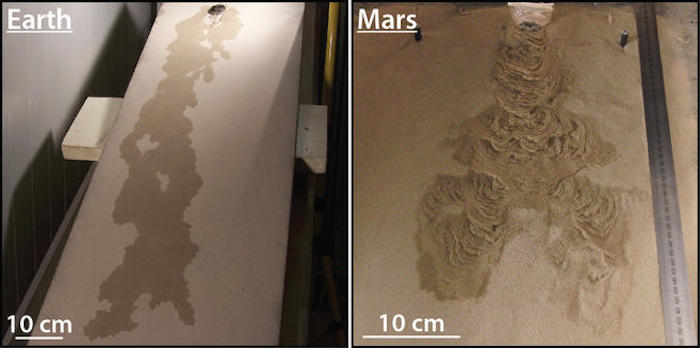.
Rather than trickling streams, salty streaks on Mars may be caused by the explosive effects of evaporating water. Belinda Smith reports.
Dark salty streaks that grow on slopes on Mars in warmer months might be helped along by evaporating water causing mini dry avalanches, new research shows, and not solely be due to running streams.
An international team of scientists led by Marion Massé from the University of Nantes in France watched as ice melted on a sandy slope in Martian conditions. Rather than the water percolating into the sand and slowly working its way down the hill, it was much more dynamic – boiling and evaporating, tossing sand grains into the air which piled up and collapsed.
This combination of wet and dry processes, published in Nature Geoscience, can explain the briny streaks that seem to "flow" down Martian craters, they say.
The Martian atmosphere is very thin – only 1% the pressure of Earth's. This means water behaves very differently on the red planet. At sea level, water here boils at 100 ºC. But on the top of Mt Everest, where the atmospheric pressure is much lower, water boils at 60 ºC.
And on Mars, it boils at 10 ºC. Given liquid water can exist only briefly on the planet's surface before it boils and evaporates in a chilly steam, how can it create dark streaks hundreds of metres long?
Massé and her colleagues decided to see if there was something else at play. In a specially designed chamber which emulated the temperature (20 ºC) and low atmospheric pressure conditions of Mars, they placed a 70-gram block of ice at the top of a 30 º slope covered with loose, fine-grained sand, and allowed it to melt.
As water trickled into the sand, they noticed it boiled most vigorously at the interface between the wet sand and the atmosphere – in other words, the front of the flow.
The explosive evaporation tossed dry sand grains ahead of the flow front into the air at up to 100 metres per second and into little piles which, once tall enough, collapsed and caused tiny avalanches dubbed "granular flows".
At the flow front, they also saw ridges form, built up by ejected sand. As the water moved through them, the process repeated down the slope until all the water melted.
Granular flows could be at least twice as large as the wet zone, which comprised a series of troughs and ridges. Briny ice, being denser than pure water ice, tended to leave shorter, wider flows.
Repeated under Earth conditions, the water simply soaked into the sand and ran down the hill.
.

Comparison of water flowing down a sandy hill in Earth and Mars conditions. The low atmosphere of Mars means the water boils and evaporates easily and produces the ridged pattern on the right.
CREDIT: M. MASSÉ
-
The special chamber didn't tick all the Martian boxes – for one, it didn't have Mars' low gravity, which is only 38% that of Earth's. If their experiments were repeated with Martian gravity, the researchers calculated the ridges would end up around 2.5 times wider.
They also acknowledge water probably isn't the only landscape shaper on Mars. Carbon dioxide ice may also play a similar role.
Wouter Marra from the University of Utrecht in the Netherlands writes in a News and Views article that confirming Massé's experiments are indeed what happens on Mars is, so far, impossible.
The Mars Reconnaissance Orbiter's High-Resolution Imaging Science Experiment (HiRISE), which first spotted the briny streaks in 2010, doesn't have the resolution needed to examine their finer details.
But, he adds, laboratory experiments such as Massé's are "essential to interpret what we see in satellite imagery and to provide information for numerical models attempting to reconstruct climate conditions on Mars".
Quelle: COSMOS
4419 Views
